Theatricality, splendor and union between the arts. These are the characters with which the innovative Baroque language, beginning in the second decade of the seventeenth century, was declined in the territories of the Ianuensis Republic, still tied to late Mannerist culture.
During the first two decades of the 17th century, in fact, the spirits of local artists were stimulated by the arrival in Genoa of four canvases (Barocci’s Crucifixion of 1596, Rubens’ Circumcision of 1605, Reni’sAssumption of 1617, and Rubens’ Miracle of St. Ignatius, also of 1620), which by their unique, peculiar, and different stylistic figures laid the foundations for the linguistic renewal of the subsequent artistic season.
The openness to the new Baroque spatial conception was initially proposed with considerable insistence within religious buildings, which, called upon (at the height of the Catholic Counter-Reformation) to renew their interiors through ambitious decorative programs, found in the exaltation of the Virgin (Immaculate Conception and Assumption) a theme that lent itself well to the development of the “relationship between figure and dilated spatiality. ”1
A reliable and illustrious testimony of “this trend in action ”2 is provided directly by Pietro Paolo Rubens who, in the second volume of the first edition of his Palazzi di Genova (made to exalt the plans and elevations of the extraordinary mansions of Genoese gentlemen ), includes no less than nine plates dedicated to the most eminent buildings of worship. It is certainly no coincidence that these include two churches that, seizing on the rampant Baroque linguistic innovation, played a decisive role in consolidating the devotion of Marian iconography: the church of Saints Ambrose and Andrew and the basilica of the Santissima Annunziata del Vastato (figs. 1-2).
The extraordinary cycles of frescoes that adorn the interiors of the buildings in question, in fact, undoubtedly mark a watershed between the late Mannerist language and the adherence to the new seventeenth-century figurative models, thus allowing us to be able to consider these two spaces as clear exempla of the early Genoese Baroque.
The church of Saints Andrew and Ambrose (known, more commonly, as “the Jesus”), built between the 6th and 7th centuries, was demolished in the mid-16th century, and in “1582 the Society of Jesus obtained from Pope Gregory XIII permission to dispose of the church, ”3 and in 1589 began the work of reconstructing and decorating the building, which lasted well into the 1540s.4 The church was rebuilt and decorated in the mid-16th century.
The ornamentation of the bright and spacious central room - fully adhering to Jesuit requirements, according to which it was obligatory to structure a space in which the “faithful could participate simultaneously in religious functions ”5 - was commissioned by the Society to Giovanni Carlone (Genoa, 1584 - Milan, 1630), a prominent member of the firm of the same name6.
The cycle, due to the multitude of scenes represented, the iconographic variety and the revealing cultural significance that such a narrative was to assume, occupied the artist for about ten years, seeing him operative “between 1615 and 1618”7 in the presbytery vault(Entrance of Jerusalem and Adoration of the Magi - until 1626 - Coronation of the Virgin, fig. 4).
 |
| 1. Genoa, church of Saints Andrew and Ambrose known as the Jesus. |
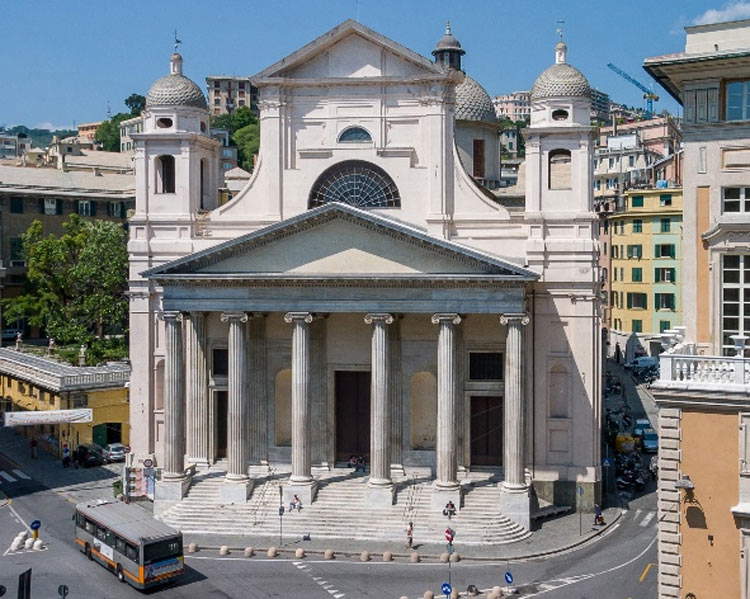 |
| 2. Genoa, Basilica of the Santissima Annunziata del Vastato |
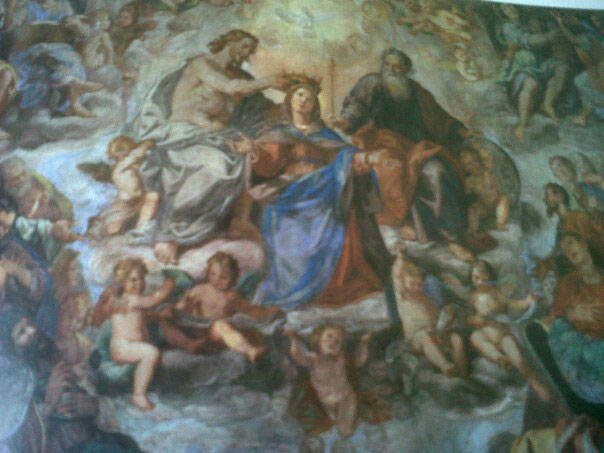 |
| 3. Giovanni Carlone, vault of the nave, Church of the Jesus |
 |
| 4. Giovanni Carlone, Coronation of the Virgin, right transept vault, Church of the Jesus, Genoa |
Although the frescoes of the entire central body (framed by refined gilded stucco borders) show greater investigation in the plastic rendering of the figures and testify to a more thorough search for overall compositional freedom, the real artistic gap between Mannerist language and Baroque “novelty” is manifested in the Glory of the Name of Jesus in the dome (fig. 5).
The authorship of the Glory, given the innovative stylistic figure adopted, is still a cause for study today. Indeed, it is surprising that on this occasion Giovanni (anchored, to the symmetrical and studied choral scenes of the late sixteenth century) operated completely independently without the probable support of his younger brother Giovanni Battista. To the latter, in fact, is ascribed a “much more cursive and gaited manner, full of accents in the motions, expressions, and color [...] especially in the fresco [where] he finds a way to light his figures with an exalted chromaticity. ”8
The decoration, in fact, animated by a swirling and “infinite” figural throng, is structured on three concentric circles that, occupying the entire space of the intrados, form a narrative continuum of absolute compositional and chromatic vivacity.
The Carlones, in the outermost band, arrange the militant church, the purging souls and the damned souls (fig. 6), then continue with theAssumption of the Virgin, surrounded by Saints and the Blessed (fig. 7), ending, finally, in the crowded choir of angels surrounding the small dome in which the monogram of Christ - “IHS” - towers (fig. 8).
What emerges, therefore, is a narrative that, following an ascending dynamic based on the dogmatic importance of the figures represented, is enlivened by a spiral of bodies, a variety of poses and colors that, immersed in an otherworldly but palpable atmosphere - evidenced by the blanket of clouds separating the respective “circles” - fully reflects the new Baroque direction (fig. 9). Recent studies place the realization of the dome in 16239, but it is equally necessary to point out the dating provided by Ezia Gavazza who, by postponing the decoration of the dome between 1625 and 162810, would presuppose the Carlones’ knowledge of what Giovanni Lanfranco - the first great exponent of the Roman Baroque season - proposed in Sant’Andrea della Valle in Rome (1625-1627) (fig. 10).
The Jesus Dome, therefore, can be identified as the first major artistic manifestation in which the new trends, coming from the sparkling environment of the Urbe, though bound to the rigid iconographic demands of the patrons, were assimilated and declined in the Genoese field11.
In the wake of the success achieved with the work of the Jesus, Giovanni Carlone, again in the early 1720s12, was entrusted with the decoration - Glorification of the Virgin and Stories of Christ - of the renovating Franciscan basilica of SS. Annunziata del Vastato, considered one of the most grandiose artistic sites of the time (fig. 11).
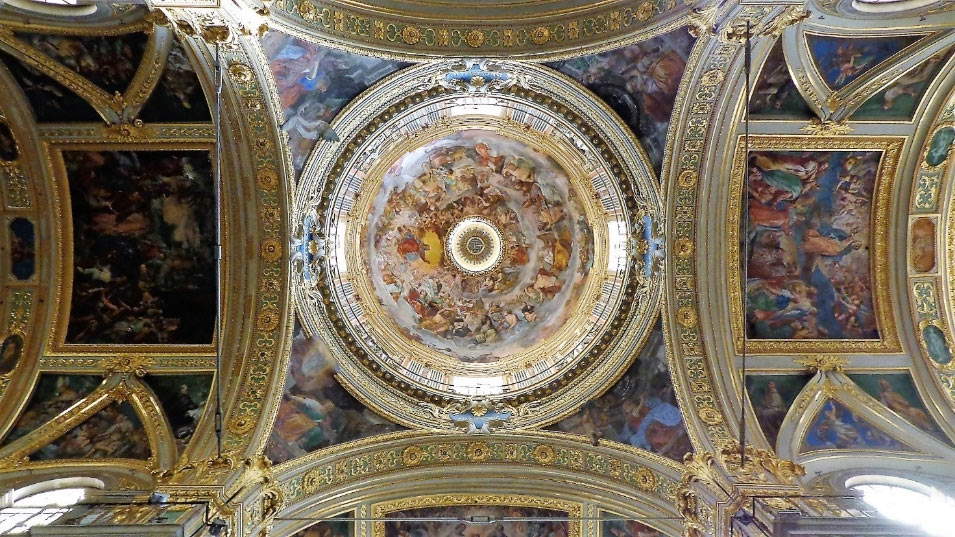 |
| 5. Giovanni and Giovanni Battista Carlone (?), Glory of the name of Jesus, dome of the Gesù church, Genoa |
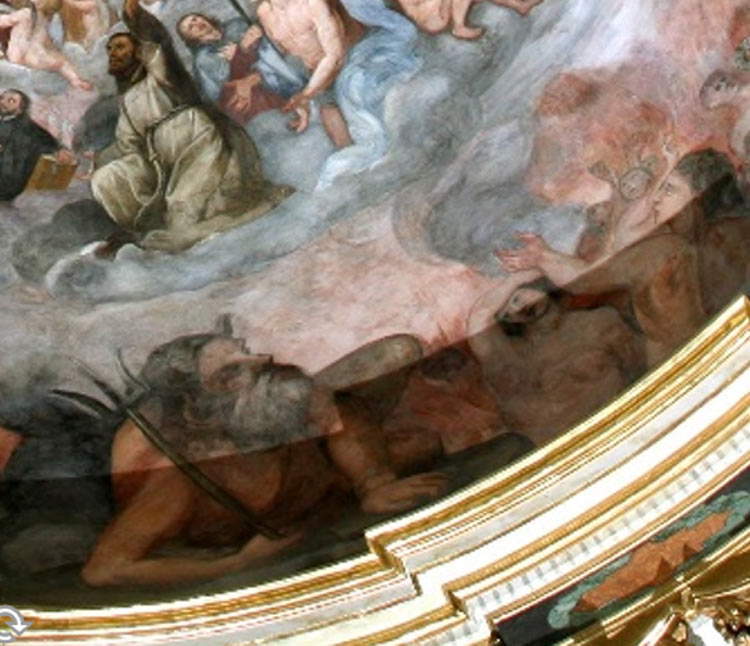 |
| 6. Giovanni and Giovanni Battista Carlone (?), Damned Souls, detail of the dome |
 |
| 7. Giovanni and Giovanni Battista Carlone (?), Assumption, detail of the dome |
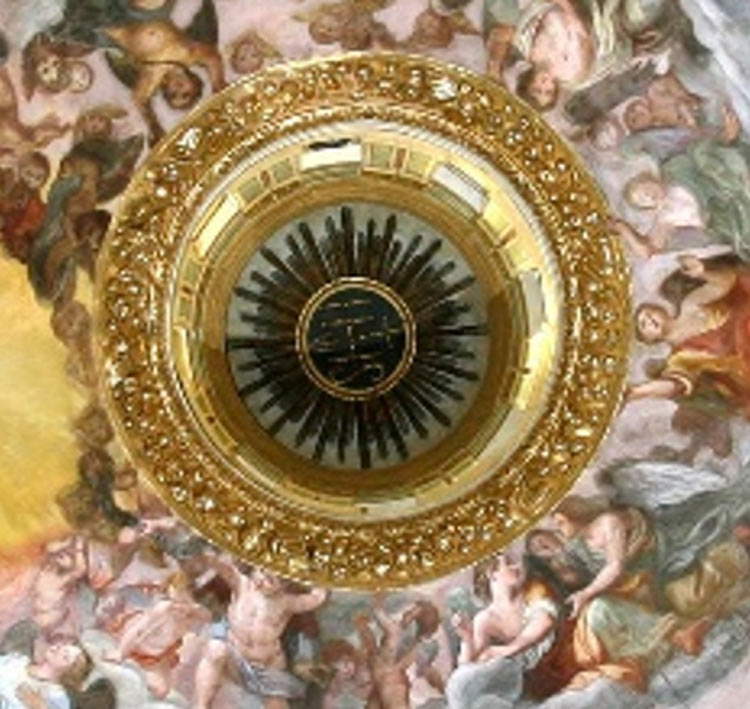 |
| 8. John and John Baptist Carlone (?), detail of the cupola |
 |
| 9. Giovanni and Giovanni Battista Carlone (?), Glory of the name of Jesus, dome of the Gesù church, Genoa |
 |
| 10. Giovanni Lanfranco, Assumption of the Virgin, dome of the church of Sant’Andrea della Valle, Rome |
Following Giovanni’s death (1630), the noble Lomellini family, wealthy and up-to-date patrons, decided to entrust the completion of the Vastato’s remarkable decorative program to the leading artists of the time, among whom, in addition to Giovanni Battista Carlone (Genoa, 1603 - Parodi Ligure, 1667), Gioacchino Assereto (Genoa, 1600 - 1649) and Giulio Benso (Pieve di Teco, 1552 - 1698), Andrea Ansaldo (Voltri, 1584 - Genoa, 1638) figures.
To complete the Carlone’s iconographic narrative for the vaults of the nave, in 1638 Ansaldo-one “among the most distinguished painters of Liguria ”13 (frescoed for the “majestic dome [...] the Assumption of the Virgin Mary into Heaven, ”14 fig.12).
TheAssumption, introduced by the figures of the Evangelists placed in the four pendentives, is articulated through a complex perspective structure in which real and illusory space coexist in a perfect unity of whole.
The drum appears to be punctuated by alternating mock and real perforations that, framed respectively with illusive twisting columns and tangible gilded stucco caryatids, give the structure an idea of rotational movement, as if to anticipate the figural vorticity of the dome. Along its entire perimeter, moreover, runs a faux-black marble balustrade from which the figures “look out” as they turn their gaze toward the Assumption, the true focus of the narrative.
A trompe-l’oeil faux loggia (echoing the underlying pattern of solids and voids and crowded with celestial and expressive figures that transcend the painted faux balustrade) subdivides in illusory perspective views the base of the dome, which Ansaldo, through the projection of faux architectural elements, connects with the lantern in which the figure of God the Father towers.
This subtle interplay between “real structures and others only imagined ”15 (in which the Regina angelorum is elevated toward the Most High by a host of cherubim, fig. 13) is reified by vivid colors, infinitely multipliable figures, and articulate gestural poses that lend an idea of engaging and frenetic spatial and compositional freedom.
The attainment of the sought-after theatricality of the whole is pursued, moreover, by the process of synthesis of the various arts (sculpture, painting and architecture, fig. 14) that together concur toward that Baroque sensibility, the pinnacle of which would be reached only years later by Gian Lorenzo Bernini with the Ecstasy of Saint Teresa in the Cornaro Chapel in Santa Maria della Vittoria in Rome (1647-1652).
 |
| 11. Giovanni and Giovanni Battista Carlone, Vaults of the nave, Santissima Annunziata del Vastato, Genoa |
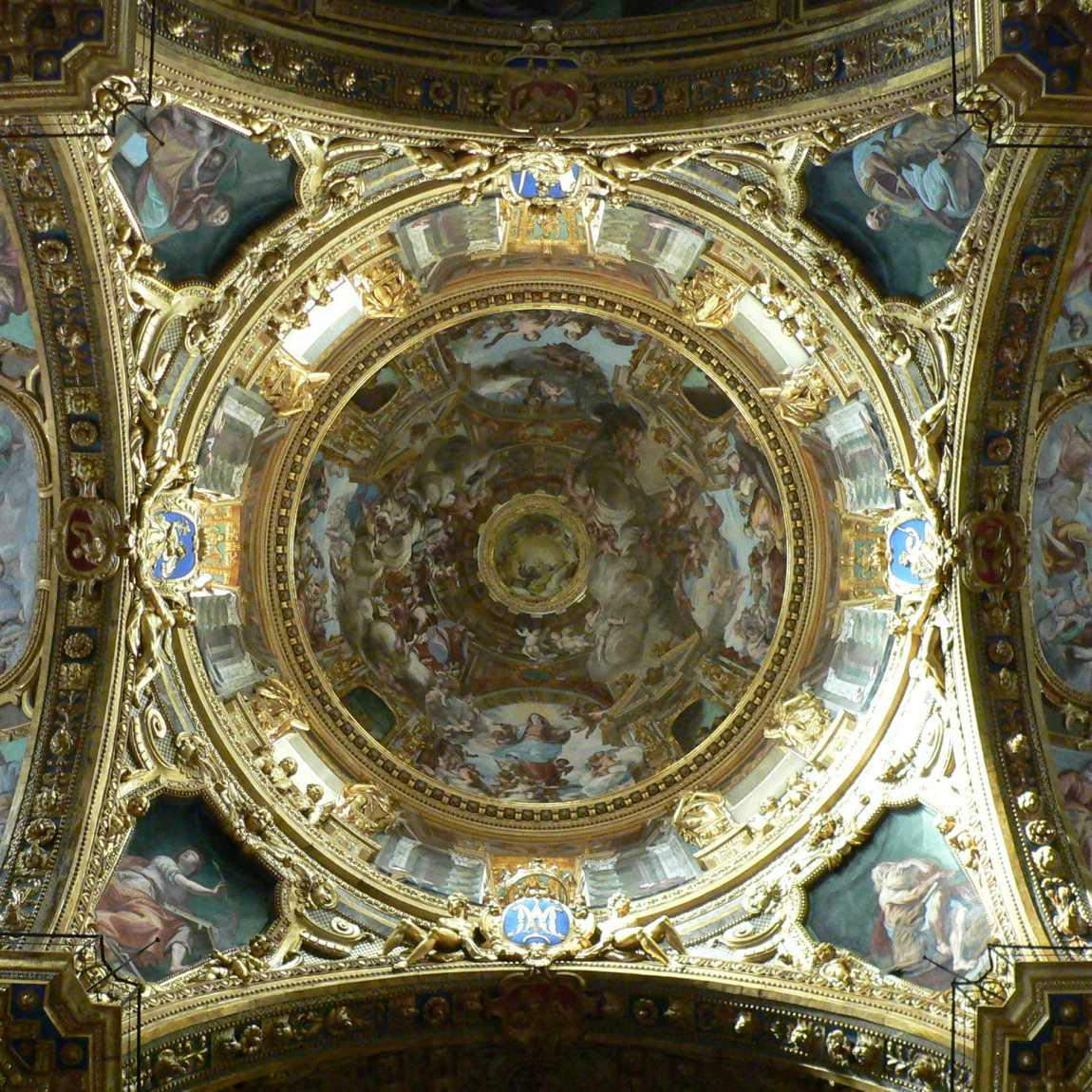 |
| 12. Andrea Ansaldo, Assumption of the Virgin, dome of Santissima Annunziata del Vastato, Genoa. Ph. Credit Klauswiki |
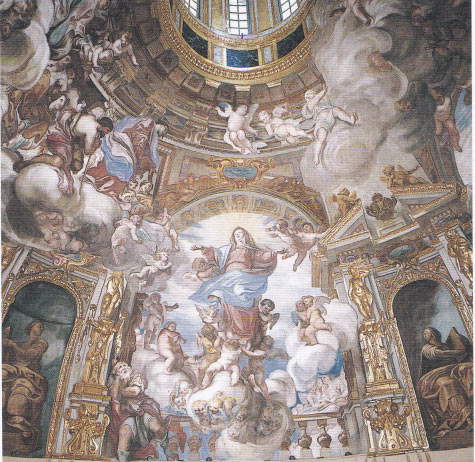 |
| 13. Andrea Ansaldo, Assumption of the Virgin, detail. Photo from: G. Rossini (ed.), L’Annunziata del Vasatato, Venice, 2005. |
 |
| 14. Andrea Ansaldo, Assumption of the Virgin, detail in which the impiety of painting (figures), architecture (balustrades) and sculpture (stucco caryatids) emerges. Photo from: G. Rossini (ed.), L’Annunziata del Vasatato, Venice, 2005 |
By virtue of this animated and varied artistic language, Ansaldo’s work originated an intense and “pathetic” narrative in the presence of which the faithful - to quote Chiabrera, a seventeenth-century poet and playwright - could have done nothing but “arch their eyelashes. ”16
The well-established understanding of the new seventeenth-century figurative stylistic features adopted by Ansaldo in the Franciscan basilica makes it possible, therefore, to consider theAssumption of the dome as “the first full affirmation of the Baroque in Genoa. ”17
Although not belonging to the most mature (and well-known) season of Genoese Baroque (identifiable, from the mid-17th century, with the best-known personalities of Valerio Castello, Domenico Piola or Gregorio De Ferrari) the Glory of Jesus and theAssumption of the Vastato appear obvious declinations of the new seventeenth-century artistic sensibility, so much so that they can rightly be considered two of the most significant “Places of the Baroque” in Genoa.
1 L. Magnani, La concezione dell’Immacolata a Genova come forma dello spazio barocca tra pittura e scultura, in L’Immacolata nei rapporti tra l’Italia e la Spagna, Genova, 2008, p. 327.
2 E. Poleggi, From walls to halls, a secret renewal, in Genoa in the Baroque Age, Genoa, 1992, p. 23.
3 R. Dugoni, Chiesa del Gesù. Santi Ambrogio e Andrea, Genoa, 1999, p. 1.
4 In fact, the six small domes that mark and animate the spaces of the aisles were decorated in the 18th century by the brushes of Lorenzo De Ferrari (1680 - 1744), Antonio Giolfi (1721 -1806) and Giuseppe Galeotti (1708 -1788).
5 Dugoni, 1999, p. 6.
6 The “Bottega dei Carlone” - originally from Rovio in Val d’Intelvi - indelibly marked the Genoese artistic scene between the 16th and 17th centuries, so much so that it monopolized first in sculpture - with the figure of Taddeo - and later in painting - with the brothers Giovanni and Giovanni Battista - most of the major local commissions of the time.
7 M. Bartoletti, An outline of Giovanni Carlone’s activity, in La terra dei Carlone. Baroque art between Genoa and the Oltregiogo, Genoa, 2019, p. 36.
8 G. V. Castelnovi, The first half of the seventeenth century in Genoa: from Ansaldo to Orazio De Ferrari, in La pittura a Genova e in Liguria dal Seicento al primo Novecento, 1987, Genoa, p. 100. Note, in this regard, the Genoese examples of The Miracle of Basil for the apsidal basin of the Basilica of San Siro and The vicissitudes of Aeneas for the gallery of Palazzo Ayrolo Negrone.
9 Bartoletti, 2019, p. 38.
10 E. Gavazza, La grande decorazione a Genova, vol. I, Genoa, pp. 112, 182.
11 It is also worth noting how the baroque importance of the church is enriched by some of the most relevant canvases in the Genoese artistic panorama, among which stand out - in addition to the works of Simon Vouet and Guido Reni - the already mentioned masterpieces of Fr. Paolo Rubens: the Circumcision of the high altar and the Miracles of St. Ignatius in the chapel named after him.
12 G. Bozzo, La decorazione pittorica delle navate, in L’Annunziata del vastato a Genova. Art and restoration, Venice, 2005, p. 79.
13 R. Soprani, Vite de’ pittori scultori ed architetti genovesi, vol. I, Genoa, 1767, p. 200.
14 Idem, p. 209.
15 G. Bozzo, La cupola, in L’Annunziata del vastato a Genova. Art and restoration, Venice, 2005, p. 96.
16 G. Chiabrera, Per il signor. Giulio Romano, in Rime, Rome, 1718, p. 296.
17 Castelnovi, 1987, p. 63.
Warning: the translation into English of the original Italian article was created using automatic tools. We undertake to review all articles, but we do not guarantee the total absence of inaccuracies in the translation due to the program. You can find the original by clicking on the ITA button. If you find any mistake,please contact us.